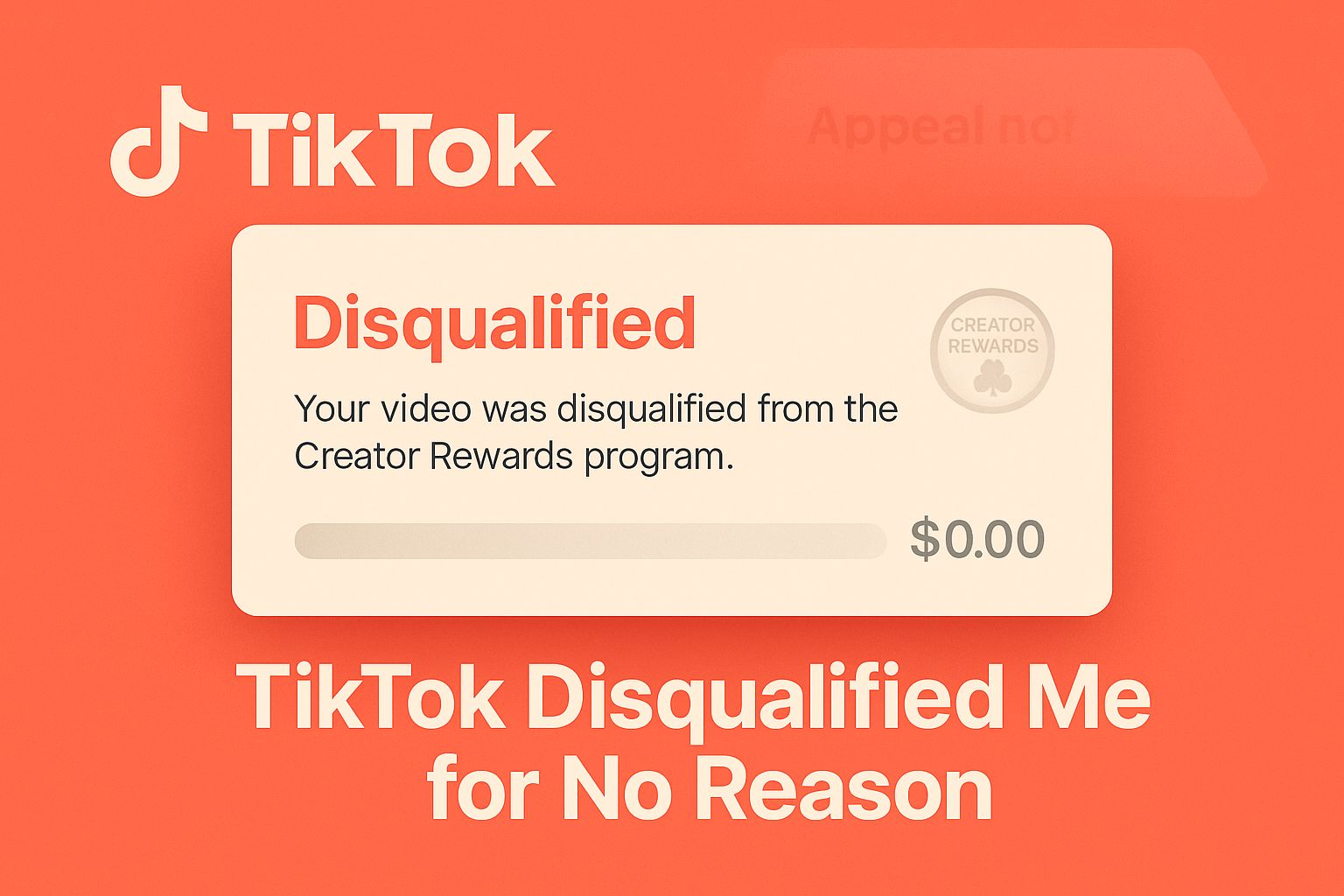The Real Reason TikTok Is Disqualifying Creators
You spend hours editing. You film original content. The video performs. You expect a payout.
Then comes the notification: “Disqualified from the Creator Rewards Program due to low quality or unoriginal content.”
You appeal.
It’s denied—within minutes. No explanation. No second chance.
This is happening to creators who’ve never reposted a thing. Creators with tens of thousands of followers. Creators who were getting paid one week and removed the next.
If you’re seeing that red “Not approved” message and wondering what you did wrong—this article is for you.
Why TikTok Is Flagging Original Content as “Low Quality”

The most frustrating part? You didn’t copy anyone. The content was yours. And still, it got flagged.
TikTok’s moderation system isn’t as manual as it wants you to believe. A lot of disqualifications are driven by automation—algorithms scanning for:
-
Reused footage (even if it’s your own screen recordings or gameplay)
-
Videos with minimal edits, static visuals, or silent narration
-
Formats that resemble meme reposts, compilations, or stitch-heavy clips
The problem is, this system often fails to recognize originality when it doesn’t look a certain way. Even if you recorded everything from scratch, TikTok can still decide it’s “unoriginal” based on patterns in format, pacing, or visual style.
Creators posting tutorials, reactions, or screen-based content (like coding, reviews, or even animations) are getting hit the hardest.
What Triggers These Disqualifications
It’s not just the content itself—it’s how TikTok’s backend interprets intent.
Here’s what increases the risk of being flagged:
-
Posting videos with little or no human presence (faceless narration, text-only formats)
-
Reusing music or visual templates that have been mass-posted by others
-
Uploading multiple similar videos that seem templated
-
Spikes in view count or engagement around payout dates (yes, really)
Some creators even report that their best-performing videos are the first to be disqualified—right when they’re about to generate real income.
That’s why some have started spacing out posts and adding more “human” elements like facial intros, original voiceovers, or direct-to-camera commentary—just to make it harder for TikTok to flag them as recycled.
The Appeal Process Is Broken by Design

Once you get flagged, TikTok gives you the option to appeal. You think, “Great, I’ll explain. They’ll see it’s a mistake.”
Then you get the automated reply—“Appeal not approved”—sometimes within minutes. No review. No feedback. No context.
Most creators never hear back. And once your appeal is denied, you can’t submit again. The decision is final.
Here’s why that’s a problem:
-
There’s no audit trail—you don’t know which video element caused the disqualification
-
Some creators are removed from the Creator Rewards Program entirely, with no warning and no path to reinstatement
-
Even large accounts with verified status and clean content histories are getting caught in the same system
TikTok may claim the process is “reviewed,” but the volume of reports, plus the speed of denial, suggests these are automated moderation decisions, not human ones.
The takeaway? If you’re appealing, keep your message short, factual, and emotion-free. Assume it’s being processed by a bot—and act accordingly.
What Creators Are Doing to Stay Monetized
Some creators have walked away. Others are building backup pages. But the ones who stay in the game are changing their approach.
What they’re doing differently:
-
Adding face or voice intros to prove originality right away
-
Using TikTok’s native tools (text, cuts, transitions) to signal it’s an “in-app” post
-
Avoiding back-to-back reposts of similar themes, even if they’re technically original
-
Breaking longer videos into mini-series to stretch watch time and engagement
-
Mixing in personality-driven posts to “train” the algorithm that it’s a real creator account
Some are also using platforms like Blaze AI to repackage content for different audiences—same message, different format—without triggering repetition flags.
This isn’t about gaming the system. It’s about creating patterns that the algorithm doesn’t misread.
How to Avoid Getting Flagged in the First Place
You can’t control TikTok’s moderation—but you can control how you publish.
Here’s what helps creators avoid the “low quality” label:
-
Start strong—the first 3 seconds should have movement, speech, or visible interaction
-
Add original voiceovers, captions, or camera-facing content wherever possible
-
Avoid uploading heavily compressed clips from other apps or software
-
Use TikTok’s built-in editing tools for at least one or two elements
-
Vary your formats: if every video looks the same, the system may assume it’s mass-produced—even if it’s not
Watch your timing too. Creators posting during known payout windows have reported more videos getting flagged. Posting earlier in the day or spacing uploads out by 24–48 hours can reduce friction.
And if you’re running more than one account, or switching between multiple IPs and devices, services like The Social Proxy help keep your sessions clean and consistent so you don’t get flagged by mistake.
How to Keep Creating Without Losing Momentum
Being disqualified once is frustrating. Having it happen over and over again—without answers—is exhausting.
The key isn’t to post less. It’s to post smarter.
Here’s what helps:
-
Create content in batches and space out uploads to prevent red flags
-
Use Flick to track what actually drives shares and replays—not just views
-
Use Systeme IO to direct TikTok traffic to an email list, product, or lead magnet you control
-
Repackage your best-performing ideas with small tweaks instead of starting from scratch
-
And when you’re low on time or ideas, lean on tools like Blaze AI to create structured scripts, outlines, or hook variations based on content you’ve already tested
Consistency beats chaos. If TikTok’s rules keep changing, your system has to be strong enough to survive the shifts.
